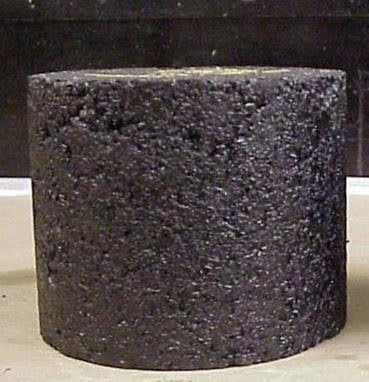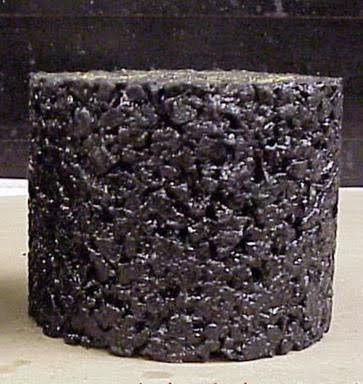The modern use of asphalt for road and street construction began in the late 1800s and grew rapidly with the emerging automobile industry. Since that time, asphalt technology has made giant strides so that today the equipment and techniques used to build asphalt pavement structures are highly sophisticated.

Asphalt Concrete is a composite material commonly used in construction of roads, highways, airports, parking lots, and many other types of pavement. It is commonly called simply asphalt or blacktop. The terms “asphalt concrete”, “bituminous asphalt concrete” and the abbreviation “AC” are typically used only in engineering and construction documents and technical literature where the definition of “concrete” is any composite material composed of mineral aggregate glued together with a binder, whether that binder is Portland cement, asphalt or even epoxy. To the layperson Asphalt Concrete pavements is most often called just “asphalt“.
Asphalt Technology Disciplines
Asphalt Technology is the study of asphalt mixes, properties and performance and can be divided into three primary disciplines;

- Dense Graded Asphalt Technology – Dense-graded mixes are produced with well or continuously graded aggregate (gradation curve does not have any abrupt slope change) and intended for general use. Typically, larger aggregates “float” in a matrix of mastic composed of asphalt cement and screenings/fines. When properly designed and constructed, a dense-graded mix is relatively impermeable. Dense-graded mixes are generally referred to by their nominal maximum aggregate size. They can further be classified as either fine-graded or coarse-graded. Fine-graded mixes have more fine and sand sized particles than coarse-graded mixes.

- Open Graded Asphalt Technology – mixes with relatively uniform-sized aggregate typified by an absence of intermediate-sized particles (gradation curve has a nearly vertical drop in intermediate size range). Mixes typical of this structure are the permeable friction course, generally called “Open Graded Friction Course” (OGFC) and asphalt-treated permeable bases. Because of their open structure, precautions are taken to minimize asphalt drain-down by the use of fibers and/or modified binders. Stone-on-stone contact with a heavy asphalt cement particle coating typifies these mixes.

- Gap Graded Asphalt Technology – Gap-graded mixes use an aggregate gradation with particles ranging from coarse to fine with some intermediate sizes missing or present in small amounts. The gradation curve may have a “flat” region denoting the absence of a particle size or a steep slope denoting small quantities of these intermediate aggregate sizes. These mixes are also typified by stone-on-stone contact and can be more permeable than dense-graded mixes or highly impermeable, as in the case of Stone Matrix Asphalt (SMA).
Asphalt Mix Types
An asphalt concrete mixture must be designed, produced and placed in order to obtain the following desirable mix properties: 1) Stability, 2) Durability, 3)Impermeability, 4)Workability, 5) Flexibility, 6) Fatigue Resistance, and 7) Skid Resistance. Asphalt/Asphalt Concrete mixes are designed for specific functions, characteristics, attributes, performance, location and function in the pavement structure. For example, asphalt surface mixes have an entirely different function in the pavement structure than base asphalt mixes and are therefore designed differently.

Surface Asphalt mixes – The “roof” over the pavement’s structural layers and are designed to be long lasting, sacrificial (designed to wear out first, protecting the underlying layers). At some point (typically 12-15 years or more after placement) they are removed by cold-planing (commonly called milling) and replaced with a new surface. Different performance characteristics in terms of surface durability, tire wear, braking efficiency and roadway noise, can also be achieved depending on application, desired function and performance.

Base Mixes – The structural strength element of the asphalt pavement system and are designed for maximum strength, distributing the wheel loads over the subbase and subgrade. Because they are protected by the asphalt “roof” (surface) the appropriate asphalt base mixes performance can be achieved economically.
Different kinds of Asphalt Concrete
To be able to provide the best performance to different sectors, a large variety of asphalt mixes can be offered. Due to the different requirements e.g. a road needs to fulfill (high traffic, tough weather conditions etc) the respective mix used needs to have an sufficient stiffness and resistance to deformation in order to cope with the applied pressure from vehicle wheels on the one hand, yet on the other hand, the need to have an adequate flexural strength to resist cracking caused by the varying pressures exerted on them. Moreover, good workability during application is essential in order to ensure that they can be fully compacted to achieve optimum durability.
- Hot Mix Asphalt (HMA)
- Hot mixes are produced at a temperature between 150 and 190 °C.
- Depending on the usage, a different asphalt mixture can be used.
- Porous Asphalt
- Stone Mastic Asphalt (SMA)
- Asphalt Concrete
- Asphalt Concrete for very thin layers
- Double layered Porous Asphalt
- Warm Mix Asphalt (WMA)
- A typical WMA is produced at a temperature around 20 – 40 °C lower than an equivalent Hot Mix Asphalt. Less energy is involved and, during the paving operations, the temperature in the mix is lower, resulting in improved working conditions for the crew and an earlier opening of the road.
- Cold Mix
- Cold mixes are produced without heating the aggregate. This is only possible, due to the use of a specific bitumen emulsion which breaks either during compaction or during mixing. After breaking, the emulsion coats the aggregate and over time, increases its strengths. Cold mixes are particularly recommendable for lightly trafficked roads.
Want to know more?
Related Links


